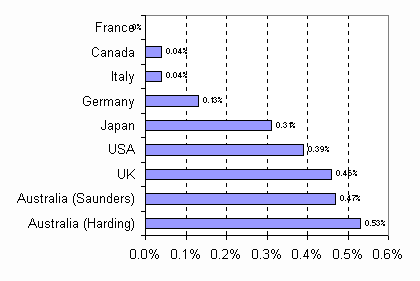please check that label on bar for France appears within the plot area not on y axis - this seems to scramble between excel and word]
Figure 1. Average annual increases in Gini coefficient for equivalent disposable income since 1979.

Advertisement
Sources: Burtless 2001, Saunders 2001 and Harding and Greenwell 2001.
Why should we be concerned about increased income inequality?
It is often argued that people on low incomes are better off even if inequality is increasing, because increased inequality is associated with higher economic growth which benefits everyone in real terms—the ‘rising tide lifts all boats’ argument. Burtless (2001) has shown that inequality has increased most rapidly in countries with the highest average levels of economic growth. There does therefore seem to be an association between increased inequality and increasing overall wealth of a country. In terms of how the wealth is shared, however, Burtless argues that the poor in European countries have done better over the last decade, despite having lower rates of growth than the UK and the USA, because the benefits have been more equally distributed.
Research from the Luxembourg Income Study supports Burtless’ argument. While acknowledging the methodological difficulties of making international comparisons, this international study of well-being examines real income differences between income groups in each country, with a particular focus on children. It does this by adjusting income for purchasing power—what someone can buy for a given amount of money in their own country. Importantly, it allows us to explore the question ‘Is someone on a particular income (measured as a point in the income distribution) in Australia better or worse off in absolute terms than someone on an equivalent income in other countries?’
The answer depends on whether you are rich or poor. Children of the rich in the USA (belonging to a family at the 90th percentile of the income distribution) are better off in terms of purchasing power than the children of the rich in any other country. Australia comes in at about the middle. For the children of the poor (a child in a family at the 10th percentile of the income distribution) the story is the opposite. Poor children in the USA are worse off in real terms than poor children in all of the other 12 OECD countries in the study, except for the UK. Australia comes 11th out of 13: only in the UK and the USA are the poor worse off than in Australia. These findings mirror those of the United Nations Development Programme (UNDP) on poverty rates in developed countries where Australia comes 14th out of 17 countries, followed only by the UK, Ireland and the USA (UNDP 2001).
Incidentally, why do Australian policy makers and economists tend to turn for ideas on combating poverty to the two countries which seem to be worse at it than we are—the UK and the USA? Perhaps it is time to think outside the directions encouraged by language barriers or shared neo-liberal doctrines.
Implications
These findings about inequality have significant implications for policy concerning people on low incomes. We must find ways to distribute the benefits of growth more equally rather than continue down the ‘high growth–high inequality’ road promoted by economic and political elites. Not only will this make Australia a fairer country, it will also make people on low incomes better off in real terms. And we must start looking for lessons on combating poverty to European countries who have demonstrated a superior capacity for reducing it than our English-speaking counterparts.
Discuss in our Forums
See what other readers are saying about this article!
Click here to read & post comments.